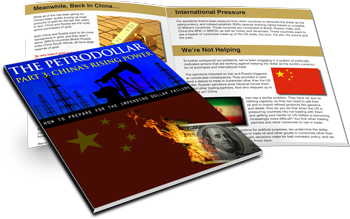
In 1944, the Bretton Woods Conference resulted in the establishment of an international gold standard and global acceptance of the dollar as the reserve currency. When economic factors forced the country to untether the dollar from gold in the 1970s, an arrangement with Saudi Arabia to standardize oil prices in dollars led to the petrodollar and preserved the dollar’s position as the world’s reserve currency. Now China is taking actions that threaten the dollar’s dominance and could generate significant demand for gold.
When Was the Petrodollar Created?
The 1944 Bretton Woods Conference looked forward to a coming victory for the Allies in WWII and the desire for new economic stability. Since the U.S. at that time owned more gold than any nation, it offered to redeem its currency in gold as a foundation for international finance. This catapulted the dollar into the position of the global reserve currency.
Less than three decades later, President Nixon cancelled the dollar’s convertibility into gold to alleviate economic pressures related to the cost of the Vietnam War, inflation, and national debt and deficit spending. This event was known as the “Nixon Shock.” In order to maintain the dollar as the world’s reserve currency the United States-Saudi Arabian Joint Commission on Economic Cooperation was established in 1974, which resulted in the creation of the petrodollar. 1
The net result of these events is that for more than six decades the U.S. dollar has ruled supreme, and has brought unprecedented financial power to the country. However, some see this position as providing exorbitant privilege that has long been envied by other governments, with China and Russia at the top of the list.
What Is Petrodollar Warfare?
The Chinese have developed a multi-pronged, long-term strategy to shuffle the world’s economic structure, and replacing the U.S. dollar as the world’s reserve currency is one of its primary goals. A major element of this is eliminating the role of the petrodollar in the international trade of oil.
The potential for this shift happening is looming as a near-term reality based on comments from Carl Weinberg, chief economist and managing director at High Frequency Economics. He is forecasting that China will soon (maybe in 2018) force the nation of Saudi Arabia to sell its crude exports denominated in yuan, instead of dollars. He explains, ‘ …even as much as one or two years from now, Chinese demand will dwarf U.S. demand. I believe that yuan pricing of oil is coming and as soon as the Saudis move to accept it–as the Chinese will compel them to do–then the rest of the oil market will move along with them.’
Major elements of the Chinese strategy include a crude oil futures contract and pricing the yuan with convertibility into gold, therefore creating the new petroyuan. This, of course, is no longer an option with U.S. dollars. This market essentially eliminates the role of the U.S. petrodollar and undermines America’s ability to use oil as a diplomatic tool. The offer to back such trades with gold provides a level of comfort to those trading partners not yet as comfortable with the (petro)yuan as they are with the traditional petrodollar. 2
What Will Happen If the Petrodollar Falls?
The discussion by Weinberg included his view of the impact of losing status as the world reserve currency. He feels any such move would lessen the demand for all U.S. securities and products. The projections made by Weinberg indicate this move will eliminate as much as $600 billion to $800 billion worth of dollar-denominated transactions. Such a reality will create greater demand within China for everything from goods and services to securities and other financial instruments. Of course, that is precisely the objective of China of this move on the global economic chessboard.
The net result in any such actions and economic movement is viewed by experts as strongly bullish for gold and a boon to long-term holders of the yellow metal. The ongoing paper currency experiment being conducted by the U.S. Federal Reserve would encounter significant new hurdles.
As the historic levels of national debt continue to grow, any loss in value of or demand for dollars will make financing that debt more difficult, much less increasing it. This could well start the economic cascade some analysts have predicted and make gold much more valuable in U.S. dollar terms.
Learn more about China’s rising power in our new Petrodollar Report.



